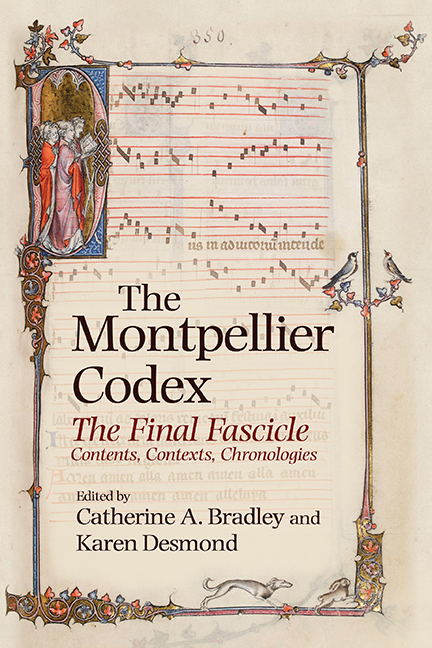Book contents
- Frontmatter
- Contents
- Figures
- Musical examples
- Tables
- Acknowledgements
- List of manuscript sigla
- Abbreviations
- Table of fascicle 8 contents
- Introduction
- I The Material Object
- II INNOVATION AND TRADITION
- 8 Texture, Rhythm, and Stylistic Groupings in Montpellier 8 Motets
- 9 Je le temoin en mon chant: The Art of Diminution in the Petronian Triplum
- 10 How Rhythmically Innovative is Montpellier 8?
- 11 Re-Presentation in the Ars antiqua: From Chant to Polyphony
- 12 … Que ne dit ‘cief bien seans’: Quoting Motets in Montpellier 8
- III ANALYTICAL CASE STUDIES
- Bibliography
- Contributors
- General index
- Index of compositions, alphabetical
- Index of compositions in Mo, manuscript order
- Miscellaneous Endmatter
9 - Je le temoin en mon chant: The Art of Diminution in the Petronian Triplum
from II - INNOVATION AND TRADITION
Published online by Cambridge University Press: 04 July 2019
- Frontmatter
- Contents
- Figures
- Musical examples
- Tables
- Acknowledgements
- List of manuscript sigla
- Abbreviations
- Table of fascicle 8 contents
- Introduction
- I The Material Object
- II INNOVATION AND TRADITION
- 8 Texture, Rhythm, and Stylistic Groupings in Montpellier 8 Motets
- 9 Je le temoin en mon chant: The Art of Diminution in the Petronian Triplum
- 10 How Rhythmically Innovative is Montpellier 8?
- 11 Re-Presentation in the Ars antiqua: From Chant to Polyphony
- 12 … Que ne dit ‘cief bien seans’: Quoting Motets in Montpellier 8
- III ANALYTICAL CASE STUDIES
- Bibliography
- Contributors
- General index
- Index of compositions, alphabetical
- Index of compositions in Mo, manuscript order
- Miscellaneous Endmatter
Summary
MONTPELLIER 8 AND THE PETRONIAN REPERTORY
ONE of the distinctive features of Montpellier fascicle 8's predominantly unica collection of motets is a seemingly innovative and even experimental tendency. The increased freedom of the triplum in the texture of three-voice writing was important to this. The composition of a new triplum for Mo 7,282 in Mo 8,330 is a clear indication of the centrality of such voice-parts to innovation. In some cases the stylistic novelty is apparent in the greater continuity of triplum phrases compared with the shorter-breathed statements of the lower voices (e.g. Mo 8,305 and 316); but the triplum may also move consistently faster than the lower voices (as in Mo 8,311). The extreme manifestation of the tendency is in the motets using the rhythmic and notational developments of Pierre de la Croix (Petrus de Cruce) (Mo 8,317, 332, and 338). In these motets the tenor is slowed down to move mostly in perfect longs, while the triplum is accelerated through the frequent use of short semibreves.
Petronian style is a feature shared with fascicle 7. Jacobus cited the tripla of the two motets commencing that fascicle (253 and 254) as illustrations of the innovation in Petrus's style. If the Petronian style is gauged in the light of these citations to depend essentially on the subdivision of the breve into more than three semibreves, then the incidence of the style in the Montpellier codex, and perhaps then of Petrus's compositional output, is easy to reckon. Ernest Sanders and Peter Lefferts followed this criterion in the New Grove article on Petrus de Cruce, identifying a repertory of eight pieces, five uniquely in fascicle 7 (253, 254, 264, 298, and 299), two uniquely in fascicle 8 (317 and 332), and one that is found with variants in both fascicles (Mo 7,289/8,338).
Although Jacobus identified Petrus specifically with the extension of Franconian practice in respect of the semibreve, he noted that Petrus did this ‘sometimes’. The implication, then, could be that Petrus's compositional practice was not limited to the exploitation of this characteristic. In his survey account of the thirteenth-century motet, Richard Crocker proposed a broader Petronian repertoire likewise extrapolating from the two pieces identified by Jacobus but not restricted to compositions using higher subdivisions. Neither essay associated 7,294 with Petrus, despite the presence of two 4-groups in the triplum.
- Type
- Chapter
- Information
- The Montpellier CodexThe Final Fascicle. Contents, Contexts, Chronologies, pp. 161 - 183Publisher: Boydell & BrewerPrint publication year: 2018
- 1
- Cited by



